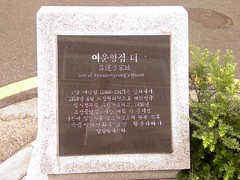When I was in Korea last month I stayed at a lovely place in the area of Seoul known as Pukchon or ‘North Village’ that lies between the two big palaces. It’s actually an area made up of many small neighbourhoods (tongs) that was once favoured by yangban aristocrats and now by the the Ministry of Culture and Tourism. It’s been discovered as a tourist area and parts of it have been ‘conserved’ while others have come to have a distinctly up-market feel with trendy cafes and so on. Having said that, not everyone there is convinced that what is being done to conserve and promote the area is actually in its best interests, as this site run by a British expat recounts.
While staying there I happened to notice a few sites of historical importance that might be overlooked on your average tour, and they are all conveniently within a few metres of one another and a stone’s throw away from the walls of Ch’angdokkung Palace in Kye-dong. None of these sites are anything to look at, as you will see from my pictures, but they should have some significance to anyone interested in the history of Korea with about half a minute to spare. So, I proudly present my 30-second tour of historical Pukchon:
Starting out from the front gate of Ch’angdokkung, take the small road up the left-hand side of the palace wall, passing the big Hyundai buildings on your left. When you come to the first left turning take this, going up a short hill. Just over the top of this on the right-hand side of the road is my first site: an engraved stone marking the site of Yŏ Un-hyŏng’s house:

I’ve written something on my own site before about Yŏ Un-hyŏng, a moderate leftist nationalist who found himself in the way of Kim Ku in the late 1940s and was assassinated not that far away from Pukchon, on the other side of Ch’angdokkung, in Hyehwa-dong. Yo was one of those important historical figures who has been somewhat swept aside by history – he had apparently met Lenin when he visited Moscow in 1922, had worked for Chiang Kai-shek and was one of the founders of the short-lived Korean People’s Republic in 1945.
Moving a little further down the street and a building that might be mistaken for a large house turns out to be the offices of the Yŏksa Munje Yŏn’guso (Institute for Korean Historical Studies):

In some ways this is an organisation that has historical importance in its own right as the main left nationalist history association to emerge from the political turmoil and radicalisation of the 1980s in South Korea. This is the organisation that founded the Yoksa Pip’yŏngsa (Historical Criticism) publishing company whose books will be found on the shelves of any historian of Korea and which publishes the important historical journal Yŏksa Pip’yŏng. The views associated with this organisation and its members are generally regarded as having achieved the status of historical orthodoxy in the Korean academy, although these days they are being challenged by new trends such as ‘postnationalism‘ and quantitative history.
Finally, if you retrace your steps a little and take the first turning on the left up a narrow street, a signboard on a building on the left side of the street should catch your attention. It’s the headquarters of the Min clan:

It would be impossible to overstate the importance of this one family in the history of late nineteenth century Korea. Somehow though, its current manifestation seems inappropriately prosaic, especially with the little scooter parked outside.
1 Comment